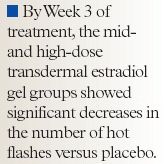- Safety & Recalls
- Regulatory Updates
- Drug Coverage
- COPD
- Cardiovascular
- Obstetrics-Gynecology & Women's Health
- Ophthalmology
- Clinical Pharmacology
- Pediatrics
- Urology
- Pharmacy
- Idiopathic Pulmonary Fibrosis
- Diabetes and Endocrinology
- Allergy, Immunology, and ENT
- Musculoskeletal/Rheumatology
- Respiratory
- Psychiatry and Behavioral Health
- Dermatology
- Oncology
From the NAMS Annual Meeting: Transdermal estradiol gel significantly decreases postmenopausal hot flashes
Results from a phase 3 clinical study demonstrate that a novel transdermal estradiol gel (Bio-E-Gel, BioSante) represents a major improvement in low-dose estrogen therapy, significantly reducing the frequency and severity of hot flashes in menopausal women in a dose-dependent manner at all 3 doses studied, with the low dose being identified as the lowest effective approach, stated James A. Simon, MD, at the North American Menopause Society's 16th annual meeting in San Diego.
Results from a phase 3 clinical study demonstrate that a novel transdermal estradiol gel (Bio-E-Gel, BioSante) represents a major improvement in low-dose estrogen therapy, significantly reducing the frequency and severity of hot flashes in menopausal women in a dose-dependent manner at all 3 doses studied, with the low dose being identified as the lowest effective approach, stated James A. Simon, MD, at the North American Menopause Society's 16th annual meeting in San Diego.
"Bio-E-Gel offers an important new treatment option for the reduction of hot flashes," said Dr Simon, clinical professor of obstetrics and gynecology at George Washington University (GWU) School of Medicine and GWU Hospital, Washington, DC, and medical director, Women's Health Research Center, Laurel, Md. "Since non-oral hormone therapy may offer a potential safety benefit, Bio-E-Gel, having demonstrated efficacy at low doses, may fill an unmet medical need."

Across all 3 transdermal estradiol gel doses tested, there was a clear dose response in the reduction of the number of hot flashes and a decrease in the severity of hot flashes. By Week 3 of treatment, the mid- and high-dose transdermal estradiol gel groups showed significant decreases in the number of hot flashes versus placebo, as well as significant reductions in the severity of hot flashes versus placebo. These significant responses were maintained from Week 4 to Week 12. Beginning at Week 5, comparable decreases were demonstrated with the low-dose transdermal estradiol gel, thus identifying the most effective low dose.
